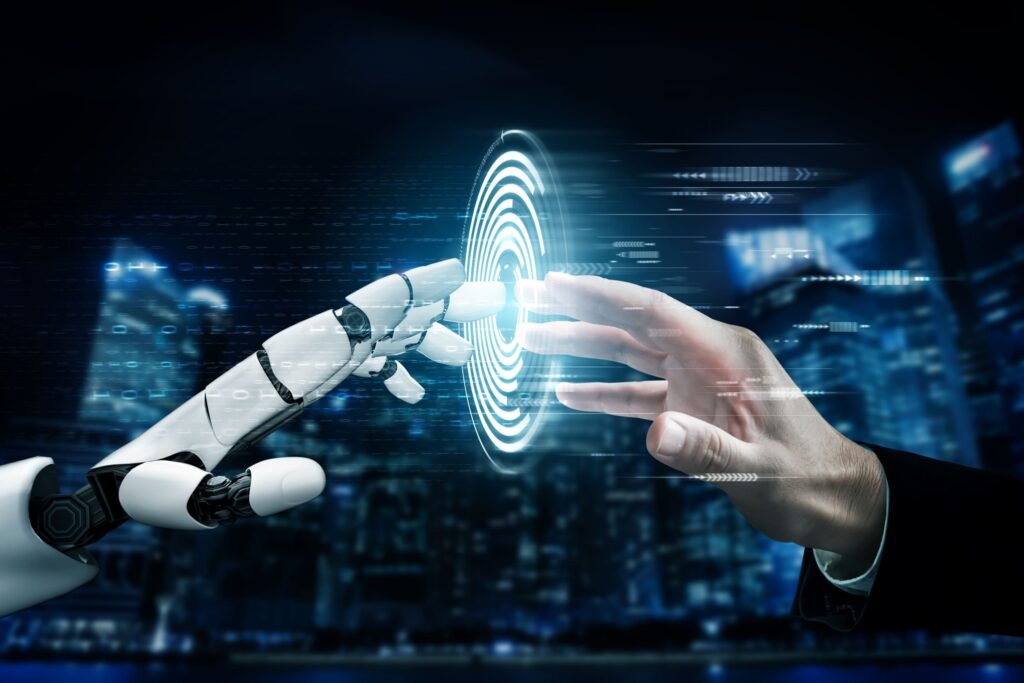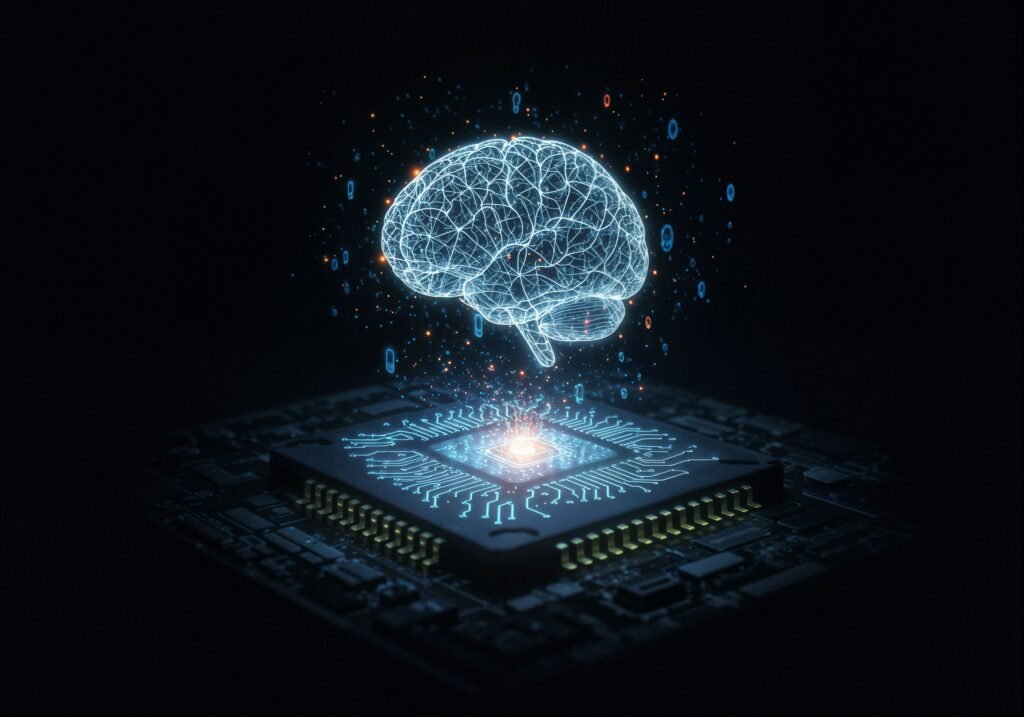Introduction: AI Is Not the Future, It’s Now
AI software development is no longer an experimental technology used by only the largest tech giants. Today, businesses of all sizes are embracing artificial intelligence (AI) to automate operations, personalize user experiences, and create entirely new products that weren’t possible before.
From healthcare and finance to eCommerce and manufacturing, the demand for intelligent digital solutions is exploding. With the right combination of strategy, algorithms, and data, AI software development is giving birth to a new generation of smarter apps and platforms.
This article is your ultimate guide to understanding everything about AI software development, including how it works, the tools involved, and the key services like generative AI development, AI/ML solutions, and custom AI model development. Let’s dive in.

What Is AI Software Development?
AI software development refers to the process of building intelligent software systems that can simulate human cognition—such as learning, reasoning, problem-solving, and decision-making.
Unlike traditional software that follows fixed rules, AI-based systems improve over time by learning from data. Developers use a range of models, tools, and technologies to build apps capable of analyzing patterns, predicting outcomes, and automating tasks.
This includes:
- Natural Language Processing (NLP) Development: Understanding and generating human language.
- Computer Vision: Interpreting and analyzing visual inputs like images or video.
- Machine Learning (ML): Training algorithms on data to identify patterns and make decisions.
- Deep Learning: Neural networks for advanced AI applications like autonomous driving or facial recognition.
In short, AI software development combines data science, machine learning, software engineering, and cloud computing to build intelligent systems.
Core Components of AI Software Development
Let’s explore the foundational pieces of a modern AI software stack:
1. Data Collection & Labeling
Every AI system starts with data. This could be images, audio, text, or tabular data from databases. High-quality labeled datasets are necessary for supervised learning models.
2. AI Model Development
Here, developers choose algorithms and architectures to solve a specific problem. This could be classification, regression, clustering, or neural networks.
Some popular AI model types:
- Decision Trees
- Support Vector Machines
- Convolutional Neural Networks (CNNs)
- Recurrent Neural Networks (RNNs)
- Transformers (used in large language models like GPT)
Custom AI model development allows companies to tailor intelligence specifically for their domain, improving accuracy and performance.
3. Model Training & Evaluation
Data scientists train the model using historical data and evaluate its performance using test sets. Key metrics include accuracy, precision, recall, and F1-score.
4. Deployment & Monitoring
Once a model is trained, it’s integrated into a product or backend system. Developers monitor its performance in real-time to retrain or optimize when necessary.
Why Businesses Are Investing in AI Software
1. Automation of Repetitive Tasks
AI tools are ideal for handling repetitive workflows like data entry, fraud detection, or inventory management.
2. Predictive Insights
Retailers can forecast customer behavior, manufacturers can predict equipment failure, and banks can assess risk in real time.
3. Personalized User Experiences
Streaming platforms, eCommerce apps, and social media use AI to tailor content recommendations based on user preferences.
4. Operational Efficiency
AI-powered chatbots, for example, reduce support costs while improving response times.
Thanks to AI ML development services, even small and medium businesses can now harness predictive intelligence previously limited to enterprise giants.
Generative AI: The Hottest Trend
If 2023 was the year of ChatGPT and Midjourney, 2024 and beyond belong to generative AI development services. Generative AI involves models that can generate original content—text, code, images, music, and more.
P.S: If you’re looking for expert guidance on navigating the evolving mobile app space, check out this insightful guide on mobile app development consulting for 2025. It dives into key trends, strategic tips, and how businesses can align their goals with the right tech solutions to build high-performance apps.

What Is Generative AI?
Unlike traditional ML that classifies or predicts based on input, generative AI creates new data. This is powered by models like:
- GPT (Generative Pretrained Transformer) for text
- DALL·E for images
- Codex for code generation
Use cases include:
- Marketing copy generation
- Code autocompletion
- Art creation
- Chatbots with personality
Businesses are adopting generative AI development services to revolutionize how content is created at scale.
AI/ML Development Services: What They Offer
Partnering with an AI ML development services provider can drastically speed up your time to market. Here’s what these services usually include:
1. Use Case Discovery
Consultants analyze your business and identify the best areas to implement AI—be it chatbots, automation, analytics, or recommendation engines.
2. Model Prototyping
Experts quickly build proof-of-concept models to demonstrate feasibility and estimate ROI.
3. Full-Stack Development
From building the backend infrastructure to creating a mobile-friendly UI, these companies handle everything.
4. Integration with Existing Systems
AI models are integrated into your CRM, ERP, or eCommerce platform seamlessly.
5. Ongoing Optimization
AI solutions are monitored and updated regularly to ensure top performance.
Whether you’re in finance, education, healthcare, or retail, AI ML development services provide end-to-end support for digital transformation.
Best AI Tools for Software Development
Here’s a list of the most effective AI tools for software development in 2025:
1. TensorFlow
An open-source framework by Google for building deep learning models. It’s scalable and perfect for large-scale applications.
2. PyTorch
Popular in the research community and favored for its flexibility and dynamic computation graphs.
3. OpenAI API
Used for integrating GPT models into apps—ideal for chatbots, summarization, or language translation.
4. Amazon SageMaker
A cloud platform to build, train, and deploy ML models at scale.
5. DataRobot
Great for automated machine learning (AutoML), making it easier for non-technical teams to build models.
6. IBM Watson
A suite of enterprise-ready tools for AI-driven customer support, language processing, and more.
These AI tools for software development help streamline the process from prototyping to deployment, giving developers more time to focus on innovation.
Challenges in AI Software Development
While promising, building AI systems is not without challenges:
1. Data Privacy & Bias
AI systems often inherit the biases present in their training data. Regulatory frameworks like GDPR and CCPA require responsible AI practices.
2. Infrastructure Costs
Training large models demands high compute resources, including GPUs and TPUs—making the process expensive.
3. Skill Shortage
There’s a growing gap between the demand and supply of AI talent. Companies often rely on external AI software development firms to fill the void.
4. Security Threats
Adversarial attacks, model manipulation, and data leakage pose serious risks to AI deployments.
AI Software Development Use Cases by Industry
Let’s break down how various industries are using AI:
Healthcare
- Predictive diagnostics
- Personalized treatment plans
- AI-assisted radiology
Finance
- Fraud detection
- Credit scoring
- Algorithmic trading
Retail
- Inventory management
- Dynamic pricing
- Personalized recommendations
Education
- Intelligent tutoring systems
- AI grading assistants
- Personalized learning paths
Logistics
- Route optimization
- Demand forecasting
- Supply chain automation
Each of these verticals benefits greatly from custom AI model development tailored to industry-specific needs.
P.S: If you’re interested in how data and AI are transforming businesses, this guide on AI data analytics and business growth offers valuable insights. It explores how combining AI with data strategies can boost decision-making, customer engagement, and overall operational efficiency.

How to Get Started With AI Software Development
If you’re thinking of adopting AI in your business, here are the steps:
- Identify the Problem
What process or decision-making task can be improved with intelligence? - Assemble the Right Team
You’ll need data engineers, ML engineers, and software developers—or partner with an expert agency. - Select the Right Technology
Choose the AI tools and frameworks that match your use case. - Build a Prototype
Start small. Test the waters with a proof of concept. - Deploy and Scale
Move the model to production, monitor results, and iterate regularly.
AI Market Report: Growth, Trends & Investment Outlook
The global AI software development market has experienced explosive growth in recent years, and the momentum is only accelerating. According to Statista, the artificial intelligence software market is expected to surpass $300 billion by 2026, fueled by increasing demand across sectors like healthcare, fintech, logistics, and retail. The rising adoption of AI tools for software development, combined with innovations in generative AI and AI model development, is significantly changing how businesses approach automation, data processing, and decision-making.
One key trend is the integration of AI into mainstream software solutions, especially with the rise of AI ML development services and tools that automate testing, debugging, and deployment. Companies are also heavily investing in generative AI development services, using models like GPT and DALL·E to enhance content creation, customer service, and predictive analytics.
The U.S. continues to lead in AI investment and innovation, but Asia-Pacific markets, particularly China and India, are rapidly catching up. In 2024, AI startup funding alone reached over $50 billion globally, indicating strong investor confidence in AI’s future potential. As enterprises move toward intelligent automation and data-driven decisions, demand for expert-led AI software development is expected to rise exponentially through 2030.
Conclusion: The Future Is AI-First
AI software development is the cornerstone of digital innovation. From generative AI development services to custom AI model development, there’s no shortage of ways businesses can benefit.
Whether you’re using AI to improve efficiency, enhance personalization, or unlock predictive insights, the tools and talent are more accessible than ever. Thanks to platforms, cloud infrastructure, and advanced AI/ML development services, you don’t need a billion-dollar budget to get started.
As AI continues to evolve, staying ahead means embracing these technologies early, experimenting, and scaling responsibly. The companies who do this now will be the market leaders of tomorrow.
Frequently Asked Questions (FAQs)
Q1. What are some real-world applications of AI in today’s software systems?
AI is now powering tools across industries—like customer service chatbots, predictive analytics in healthcare, fraud detection in banking, and recommendation engines in e-commerce. Its integration helps streamline processes and deliver smarter user experiences.
Q2. How is generative AI different from traditional AI models?
Generative AI can create new content such as text, images, or even code based on patterns it has learned, while traditional models are mostly used for recognition, classification, or predictions.
Q3. Do I need a big team to start an AI-based software project?
Not necessarily. While larger teams can help scale faster, even startups can begin with a small group of skilled developers, especially by using modern frameworks and third-party tools that simplify the process.
Q4. Is it expensive to build solutions powered by artificial intelligence?
It depends on the complexity and scale. Some projects can start with affordable prototypes using open-source libraries, while more complex systems might require significant investment in model training, infrastructure, and data processing.
Q5. How do companies ensure responsible and ethical use of AI?
They follow practices like bias testing, transparency in algorithms, using diverse datasets, and compliance with data privacy laws. Many also consult ethics boards or adopt frameworks like Explainable AI (XAI).





